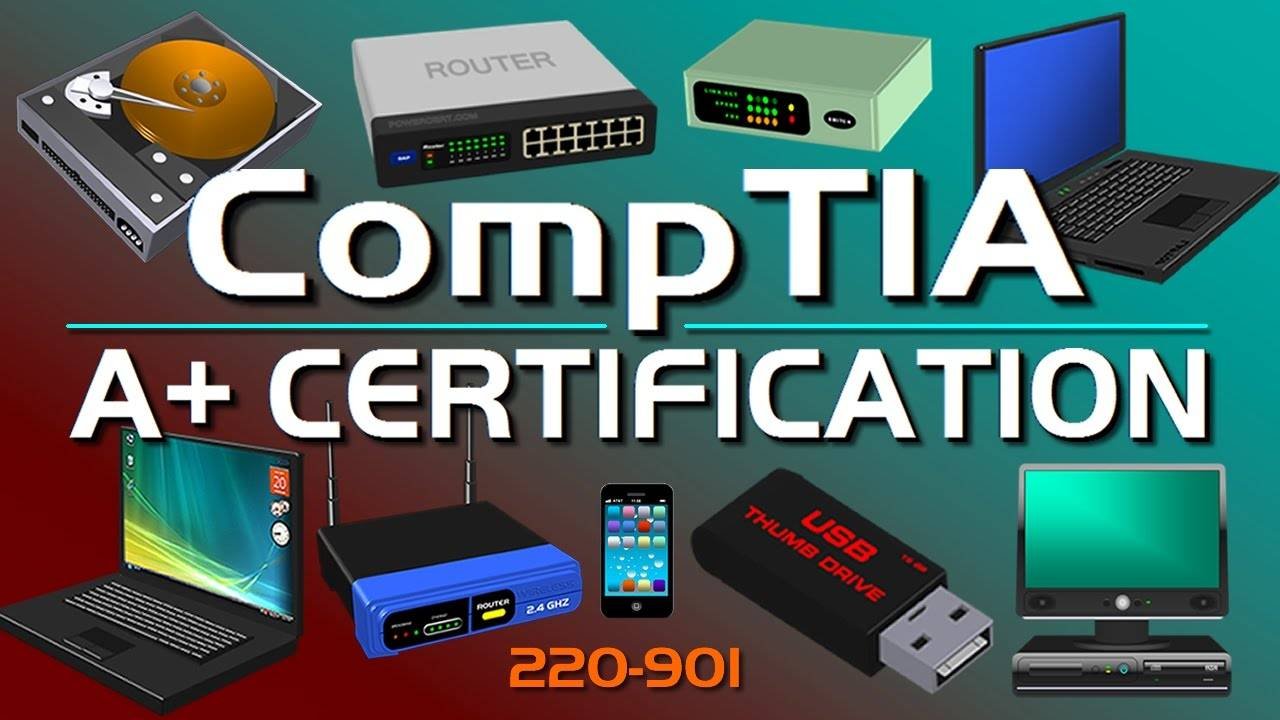CompTIA Cybersecurity Analyst (CySA+) CS0-002 Video Course by Pearson IT Certification. CompTIA Cybersecurity Analyst Get here the course https://bit.ly/3JSwU14 CompTIA Cybersecurity Analyst 20 Hours of Video Instruction by Pearson IT…
CompTIA A+ Complete overview

This guide helps you get a better grasp of what is involved with studying for the CompTIA A Plus certification exam.
The CompTIA A+ certification exam has been designed as the leading industry standard to determine computer technician’s hardware and software knowledge. Often referred to as the “entry-level” exam, the A+ exam is actually one of the few tests that require you to pass not just one, but two parts:
- A+ Core Hardware
- A+ Operating Systems Technology Exam
Review of exam specifics
Exam costs: $152 each. CompTIA corporate members can take the exams for $98. Employers that require this test are usually corporate members and will inform you of this. You can also buy exam vouchers for VUE or Prometric to get a discount. Check the CompTIA store for exam vouchers.
Exam location: You can register for the exam at any Pearson VUE and Thompson Prometric center.
Locate an authorized Pearson VUE testing center near you
Locate an authorized Prometric testing center near you
Time allocated: 90 minutes per exam
Total marks: 900
Minimum pass marks: 515 for A+ Core & 505 for A+ OS
Number of questions: Approximately 80 questions per exam
Exam format: Linear format; computer-based test (CBT)
Prerequisites: None
Validation period: Certification does not expire however it is recommended you upgrade to the latest exam version when objectives are revised.
Score report: Delivered immediately on test completion.
Exam pattern
The question types found on the A+ exam are:
- Multiple choice with single answer: Student is required to select a single answer from a range of options (generally 4-5) by clicking on a radio button.
- Multiple choice with multiple answer: Student is required to select a range of options. The number of options to select is specified.
- Fill in the blank: Student is required to type in the missing text to complete the sentence.
Exam objectives
A+ hardware
| Domain | % of examination |
| Installation, configuration and upgrading | 35% |
| Diagnosing and troubleshooting | 21% |
| Preventive maintenance | 5% |
| Motherboard/processors/memory | 11% |
| Printers | 9% |
| Basic networking | 19% |
| Total | 100% |
A+ OS technologies
| Domain | % of examination |
| OS fundamentals | 28% |
| Installation, configuration and upgrading | 31% |
| Diagnosing and troubleshooting | 25% |
| Networks | 16% |
| Total | 100% |
Topics on A+ hardware
- Installation, configuration and upgrading — 35%
- Identify physical parts
- Motherboard
- Firmware
- Power supply
- Storage devices
- Memory (physical vs. cache)
- Portable storage devices
- Network cards and network cables
- Printers
- Identify IRQ, I/O and DMA settings
- Legacy devices
- Identify port types
- Serial
- Parallel
- Infrared
- Wireless
- SCSI
- RAID (0,1,5)
- Diagnosing and troubleshooting — 21%
- Hardware vs. software problems
- Troubleshooting techniques
- Tools of the trade
- Cooling systems
- Adapters
- Portable systems
- Preventive maintenance — 5%
- Cleaning compounds
- Non-static vacuums
- Ventilation
- Hard drive maintenance (defrag)
- UPS (uninterruptible power supply)
- Motherboard/processors/memory — 11%
- Popular CPU chips
- Voltage
- AT/ATX power supply
- Speeds
- Cache (LI, LII, LIII)
- Memory types (FPM, EDO, RAMBUS, SIMM, DIMM)
- USB, AMR, CNR
- CMOS settings
- Plug-and-play BIOS
- Printers — 9%
- Printer types (laser, ink jet, dot matrix)
- Interface types (serial, parallel, USB, SCSI, IEEE1394)
- Local vs. network printing
- Troubleshooting
- Error codes
- Basic networking –19%
- Cable types (coaxial, UTP, STP, fiber)
- Connector types (BNC,RG45)
- Concepts
- Installing network cards
- Addressing
- Bandwidth
- Protocols
- Topologies (LAN, WAN, DSL, CABLE)
- Topology wiring
Topics on A+ operating systems
- OS fundamentals — 28%
- Differences between the major versions of MS Windows (9x, NT, 2000, XP)
- Operating system components (registry, virtual memory, file systems)
- System interfaces (command line vs. graphical user interface)
- Identify major system files and their purpose
- Disk partitions and configuring (primary vs. extended partitions)
- File systems and sizes (FAT 16, FAT 32, NTFS4/5)
- Directory structures (navigating and creating)
- Files (naming, attributes, tools, encryption, permissions)
- Disk management tools
- System management tools
- File management tools
- Installation, configuration and upgrading — 31%
- Identify procedures involved with installing and upgrading operating systems
- Hardware compatibility
- Minimum requirements
- Installation types (local vs. network)
- Starting installation
- Partitioning the hard drive
- Use the correct setup utility (setup vs. winnt vs. winnt32)
- Driver configuration (default and upgraded drivers)
- Troubleshooting installation errors
- Diagnosing and troubleshooting — 25%
- Identify error messages and error codes
- Boot failures
- Startup errors
- System.ini and Win.ini files
- Utilities (Dr. Watson, boot disk, event viewer)
- Boot disk
- Startup modes (safe mode, safe mode with command prompt, last known good configuration)
- Device manager
- Recovery CD
- Troubleshoot printing problems (windows print spooler)
- Windows NT, 2000 and XP BSOD (Blue Screen of Death)
- Network boot failures
- Networks — 16%
- Configure protocols
- TCP/IP vs. IPX/SPX
- Gateway
- Manual IP addressing
- Subnet mask
- Apple Talk
- Network command line tools
- Ping, Tracert, IPconfig, winipcfg
- Network protocols
- HTTP/HTTPS (normal vs secure communication)
- FTP and Telnet
- Installing and configuring browsers
- Firewalls and security
This is only meant as a quick overview for you to get a better grasp of what is involved with studying for the CompTIA A Plus certification exam. If you are 100% committed to following through with your entry into the IT world, we highly suggest you visit the CompTIA A+ Pearson Website to get the study materials for your exam.

